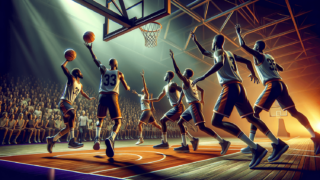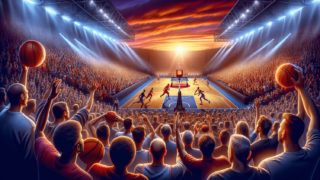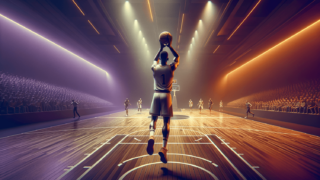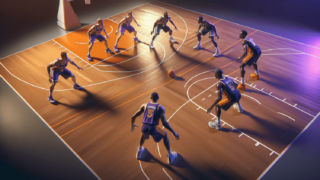
Evolution of Basketball Training Equipment
Written by: Basketball Universe
Last updated:

From the humble origins of a peach basket to the technologically advanced training gadgets of today, the world of basketball training equipment has evolved to meet the needs of increasingly competitive and sophisticated athletes. In this exciting blog post, we’ll delve into the rich history and innovative milestones that have shaped the way players train, enhance their skills, and unlock their full potential on the court. So, lace up your sneakers and join us as we bounce through time, exploring the game-changing innovations that have transformed the world of basketball training equipment. It’s time to equip your enthusiasm for the sport and get ready to learn!
Evolution of Basketball Training Equipment
The evolution of basketball training equipment can be traced from the early use of simple tools such as peach baskets and ladders, to the incorporation of leather balls, gyms, and standard baskets, and further along to the development of specialized training tools like resistance bands, plyometric platforms, and shooting machines. Advancements in technology have also played a role, with the introduction of wearable sensors and analytics software providing athletes with comprehensive data to enhance their skills and training regimens.
An Ode to the Peach Basket: The Foundation of Basketball History
In 1891, Dr. James Naismith invented basketball using a simple peach basket as the game’s first hoop. Little did he know that he was laying the groundwork for an entire industry dedicated to basketball training equipment. This unassuming peach basket serves as a reminder of the game’s humble origins and the importance of practice and training in shaping the sport as we know it today.
Leather Balls: The Evolution of the Basketball Itself
Early basketballs were made from leather panels stitched together and filled with a bladder. Although primitive, these basketballs were a critical piece of training equipment for athletes who were serious about practicing their skills. Over the years, the leather basketball has evolved to include synthetic materials, improved grip, and better aerodynamics, revolutionizing the game in more ways than one.
Hoops and Backboards: The Emergence of Better Training Equipment
As basketball continued to progress, the design and materials for hoops and backboards began to evolve. The peach basket quickly gave way to wooden backboards with iron hoops and nets. The removable nets of today’s hoops, created to facilitate faster turnarounds, were born from the inconvenience of having to remove the ball from the basket during the game manually.
Adjustable Portable Hoops
Portable hoops with adjustable heights have been game-changers for those looking to practice at home. They can cater to all skill levels and player heights, allowing athletes to undertake a more personalized basketball training program. With a configurable height range, these portable hoops help players experiment with various rebound angles, ultimately enhancing their skills on the court.
The High Jump: Incorporating Plyometric Training and Jump Enhancing Devices
Plyometric training has revolutionized basketball performance by improving players’ explosive strength and aggressiveness on the court. Plyo boxes of varying heights and jump enhancing devices, such as resistance bands, have become essential for athletes serious about increased vertical leaps and aerial prowess.
Jumpsoles and Strength Shoes
An exciting addition to the equipment for plyometric training is the advent of Jumpsoles and strength shoes. These specialized footwear options are designed to place more emphasis on the calf muscles by using a platform at the forefoot, thereby improving players’ balance and jump heights.
Shooting Machines: Pushing the Limits
Consistency and accuracy in shooting are integral to basketball success, and the innovation of shooting machines has been pivotal in taking players’ shooting abilities to new heights. These machines return the ball to the shooter after a shot, speeding up the training process and allowing for focused practice on form and accuracy.
Sharper Shooter: Smart Shot Detection
The Sharper Shooter is an advanced shooting machine with a built-in smart shot detection system. By evaluating the shooter’s form in real-time, this device provides invaluable feedback on shooting accuracy and efficiency, allowing athletes to make adjustments and perfect their shooting form on the fly.
Improving Agility: Innovative Dribbling Aids
Dribbling is a skill that does not come easy to many, but the development of innovative dribbling aids has revolutionized the way players train. From simple cones and ladders for fundamental drills to the more sophisticated Dribble Stick and Head-Up basketball goggles, multiple tools have emerged to enhance dribbling skills and improve players’ control over the ball.
The PowerHandz
Weighted gloves, like the PowerHandz, place an additional challenge on athletes during dribbling drills, forcing them to work harder to maintain ball control. When transitioning to regular play, the extra weight makes dribbling feel effortless, giving players a new level of confidence on the court.
Resistance Training: Harnesses and Bands
Resistance training has become a staple activity for basketball players focused on building strength, speed, and agility. Harnesses and resistance bands have evolved accordingly, offering variety and versatility to all training exercises, from dribbling and shooting to rebounding and defensive drills.
The VertiMax System
The VertiMax system is a prime example of innovative resistance training equipment. It employs a set of resistance bands attached to the athlete’s body and the floor, providing versatile exercise options tailored to individual skill levels and goals. The VertiMax system can help players improve their vertical leap, explosiveness, speed, and overall athleticism on the court.
Tracking and Analytics: The Tech Side of Basketball Training
The digital age has transformed basketball training, as wearables and sophisticated analytics software provide vital information to athletes and coaches alike. Players can now track various aspects of their game, like shooting accuracy, hang time, distance covered, and more, allowing them to pinpoint specific areas for improvement.
ShotTracker and HomeCourt Apps
Technological advancements have led to the creation of several mobile apps and wearable devices, such as ShotTracker and HomeCourt, that track shooting data in real-time. These apps help players identify trends in their shooting technique, ultimately leading to better performance in games.
Conclusion
As the game of basketball has evolved, so too has the equipment used to train its athletes. From humble beginnings with peach baskets and leather balls, innovations like shooting machines, dribbling aids, resistance training tools, and smart analytics have transformed the world of basketball training equipment. By embracing these advancements, modern athletes continue to unlock their full potential on the court.
Expanding Athleticism: Strength and Conditioning Tools
Strength and conditioning play a significant role in a player’s overall athletic ability and performance on the court. The evolution of training equipment in this area has improved basketball players’ power, stamina, and overall physical readiness for the game.
Weighted Vests and Ankle Weights
Weighted vests and ankle weights are popular tools used by athletes to increase resistance during exercise, building strength and endurance. By incorporating these tools into their training regimen, basketball players can enhance their explosive power, speed, and agility both on and off the court.
Kettlebells and Medicine Balls
Kettlebells and medicine balls have become favored workout tools for basketball players, as they offer a versatile and functional approach to strength training. These tools are commonly used in exercises designed specifically to improve core strength, balance, and stability, which are all critical aspects of a basketball player’s game.
The Importance of Recovery: Foam Rollers and Massage Tools
Recovery is a crucial aspect of any athlete’s training regimen. The proper maintenance of muscles and fascia can lead to better performance and reduce the risk of injury. Therefore, tools like foam rollers and massage devices have gained popularity within the basketball training scene.
Foam Rollers
Foam rollers are cylindrical tools often used for self-myofascial release or a form of self-massage. By targeting tight and sore muscle areas, foam rollers can help improve flexibility, range of motion, and overall muscle recovery. This practice has become an integral part of many basketball players’ daily routines.
Massage Therapy Devices
Handheld massagers and other massage therapy devices, like percussion massagers, help alleviate muscle tightness and soreness while promoting circulation and overall muscle recovery. These devices have become increasingly popular as a form of post-workout recovery or part of a training athlete’s overall maintenance program.
Refining Coordination: Balance and Proprioception Training Tools
Basketball players require exceptional balance and coordination, making it essential to include exercises targeting this aspect of athleticism in their training routines. Several innovative balance and proprioception tools have emerged in the market to help improve these skills, ultimately enhancing players’ performance on the court.
BOSU Balance Trainer
The BOSU Balance Trainer, with its unstable surface, challenges athletes’ stability, forcing them to engage their cores and stabilizing muscles actively. The versatile design of the BOSU Balance Trainer allows for a wide range of exercises, improving balance, coordination, and overall proprioception for basketball players.
Balance Boards and Wobble Boards
Balance and wobble boards have become popular tools for basketball athletes, as they compel players to maintain balance and engage stabilizing muscles. Incorporating these boards into a basketball training routine can improve overall balance and coordination, resulting in better control on the court.
Customized and Personalized Training
As the world of basketball training equipment continues to evolve, a new focus on personalized training regimens is emerging. Through apps, trainers, and customized programs, athletes can tailor their training to target their specific strengths and weaknesses, helping them to excel on the court.
Online Personal Trainers and Basketball Training Apps
Online personal trainers and basketball training apps offer a seamlessly tailored approach to building comprehensive training programs. These advances in technology help players establish personalized workout regimens to address their unique skillset and targets, taking their game to new heights.
Frequently Asked Questions: Basketball Training Equipment
Explore the answers to some interesting and common questions related to basketball training equipment to enhance your knowledge and help you make informed decisions as you elevate your game.
1. Are shooting machines worth the investment for basketball training?
Yes, shooting machines can significantly boost your shooting skills by allowing you to practice more efficiently and effectively. They ensure that the ball is returned to you quickly, enabling you to focus on form and accuracy during repetitive shooting drills.
2. How do plyometric exercises help in improving basketball performance?
Plyometric exercises involve powerful, explosive movements that improve athletes’ strength, agility, speed, and vertical jump. Incorporating plyometrics into basketball training helps players develop the necessary explosiveness and athleticism required for optimal performance on the court.
3. How should I incorporate resistance bands into my basketball training routine?
Resistance bands can be used in various exercises, such as shooting, dribbling, and defensive drills. They provide progressive resistance, meaning the more you stretch them, the more intense the resistance becomes. Use resistance bands to build strength, improve flexibility, and enhance overall athletic ability for better performance in basketball.
4. Are there any specific exercises to work on my vertical leap?
Several exercises target the muscles necessary for a higher vertical leap, such as box jumps, depth jumps, and weighted lunges. Incorporating these exercises alongside strength training and plyometric drills can produce significant improvements in vertical jump height for basketball players.
5. Can weighted gloves help improve my dribbling skills?
Weighted gloves challenge basketball players during dribbling exercises by increasing resistance, forcing them to exert more effort in maintaining ball control. As athletes transition back to regular play without the gloves, dribbling should feel smoother and more effortless.
6. What is the role of technology in basketball training and analytics?
Technology has become an integral part of basketball training by providing valuable insights through wearables and analytics software. Athletes can monitor their performance, identify trends, and track improvement, enabling them to make informed adjustments in their training routines and unlock their full potential on the court.
7. Should I use a portable basketball hoop for home practice?
Portable basketball hoops can be an excellent investment for your home practice. With adjustable heights to cater to various skill levels and player heights, they allow for personalized practice sessions that can have a significant impact on your game.
8. Does balance training provide any specific benefits for basketball players?
Balance and proprioception training can improve a basketball player’s overall stability and coordination, critical factors for success on the court. By enhancing core strength, players will also experience better control during various moves, like pivoting, jumping, and driving to the basket.
9. What are the benefits of self-massage and foam rolling for basketball players?
Self-massage and foam rolling can help basketball players improve their muscle recovery, reduce tightness, and alleviate soreness. By focusing on areas of tension and restricted movement, athletes can improve their flexibility and range of motion, leading to enhanced performance and reduced risk of injury on the court.
10. Can online personal trainers and basketball training apps improve my game?
Online personal trainers and basketball training apps can provide personalized workout regimens tailored to your individual strengths and weaknesses. These platforms often include video tutorials, tracking systems, and customizable plans, making them an effective way to guide and support your training journey and help you elevate your game to new heights.
Featured Posts
- No pillar pages found.





